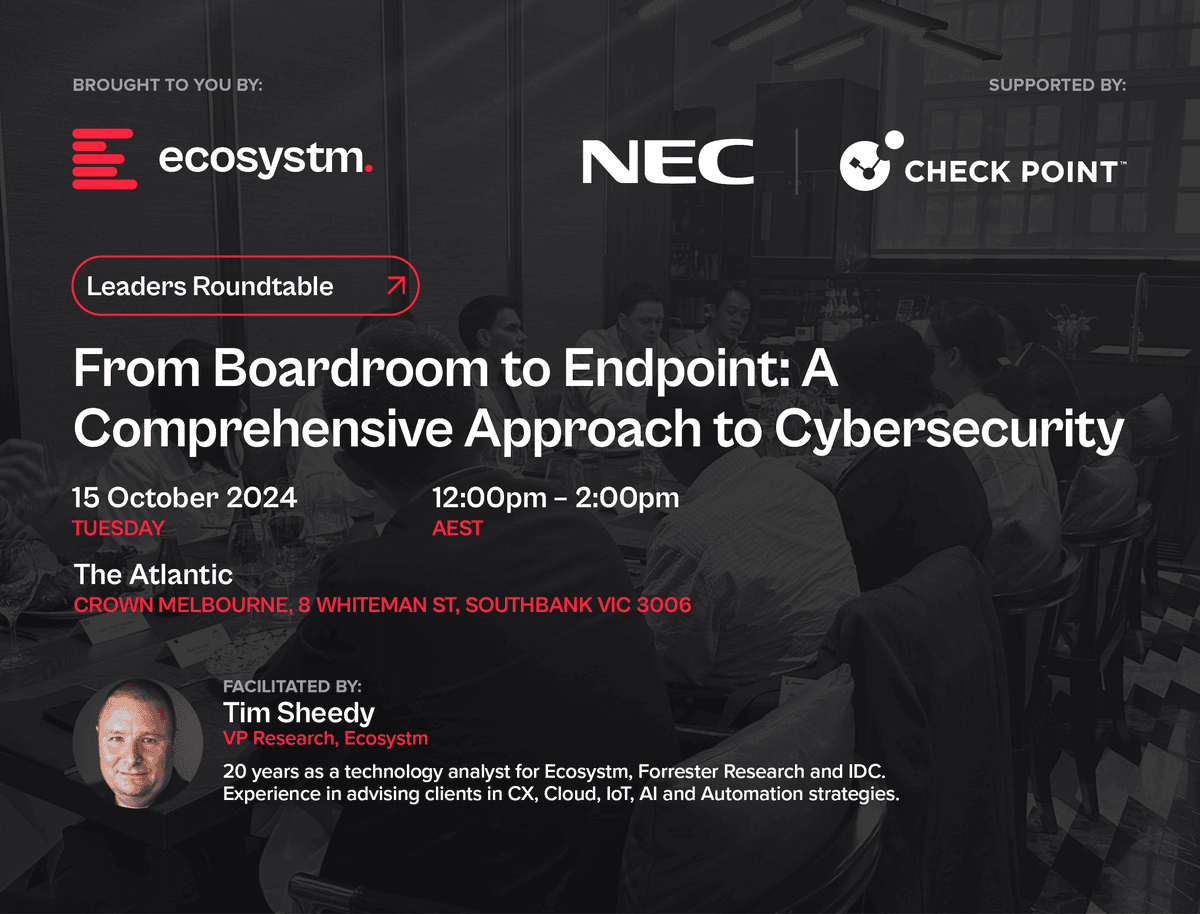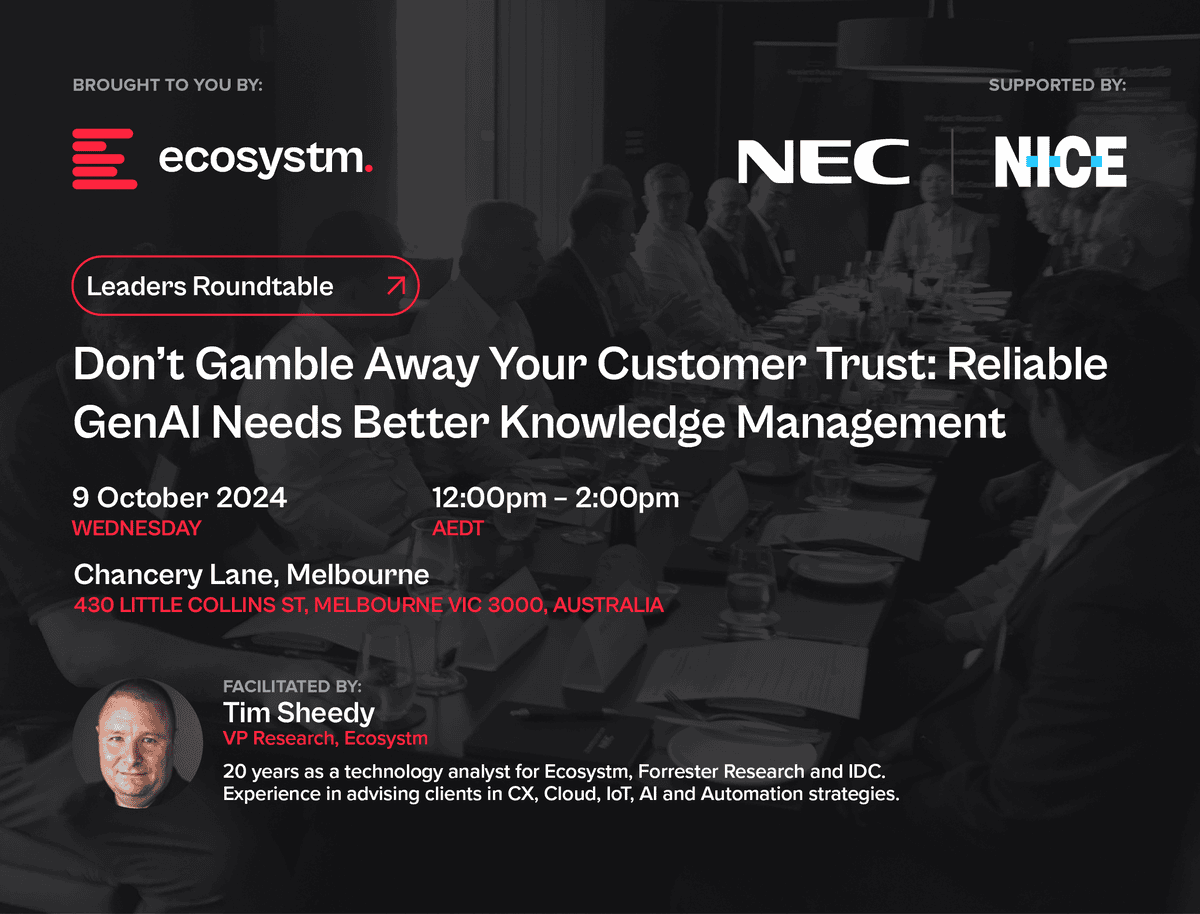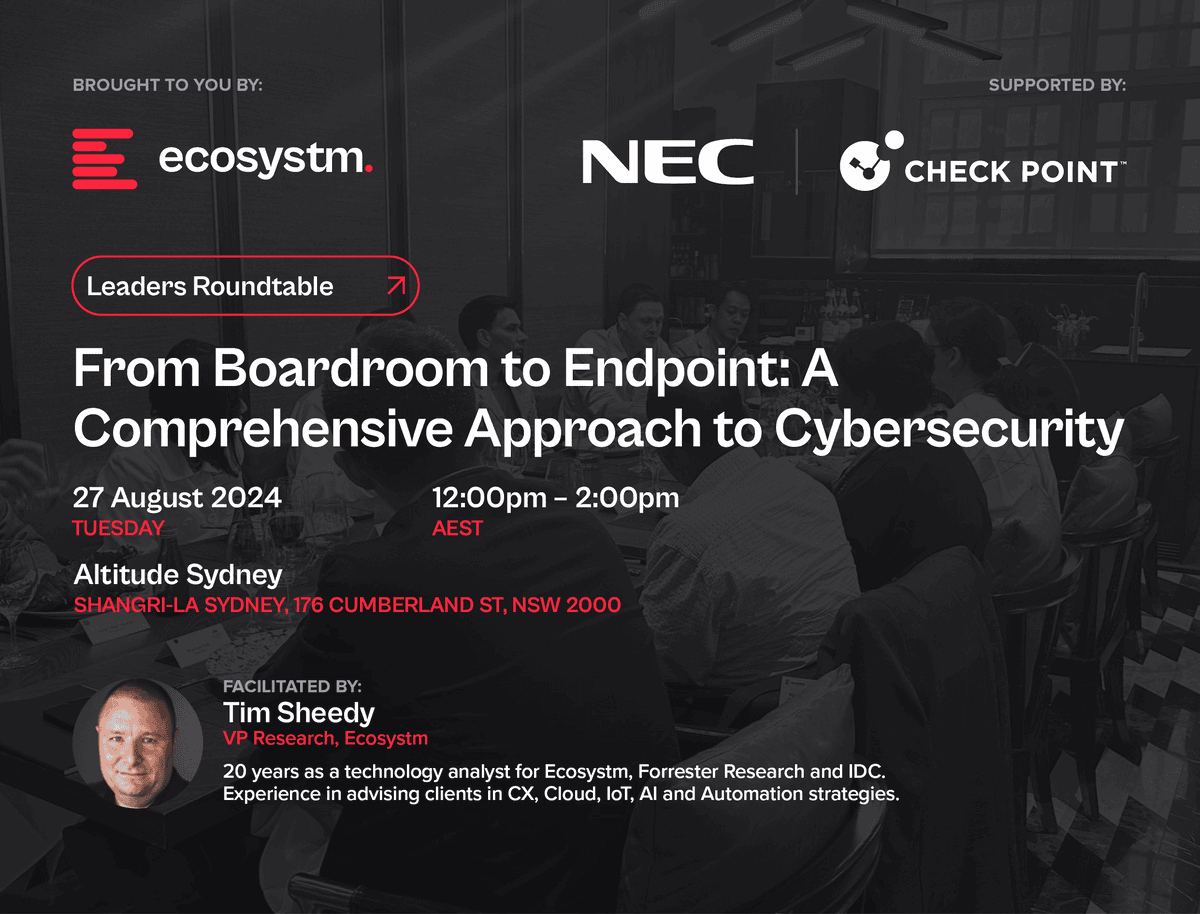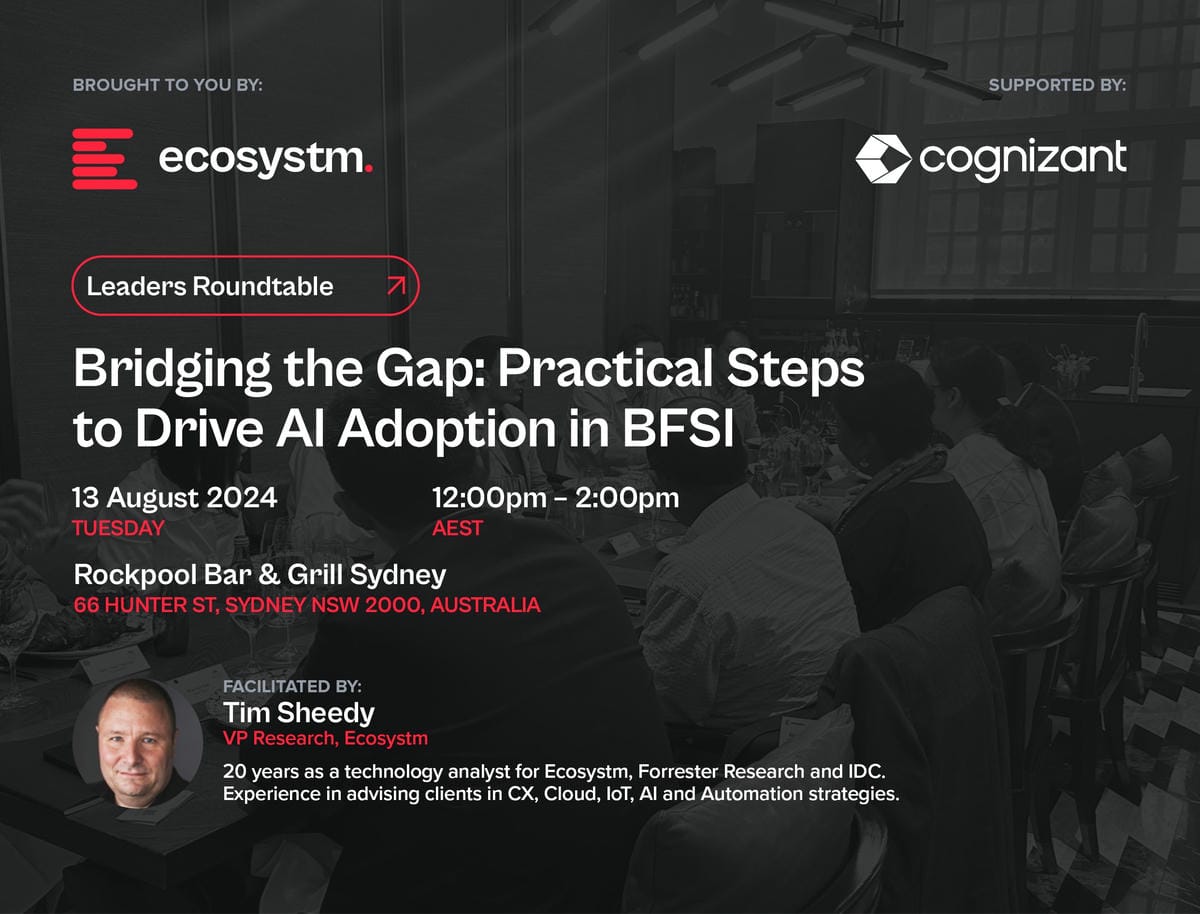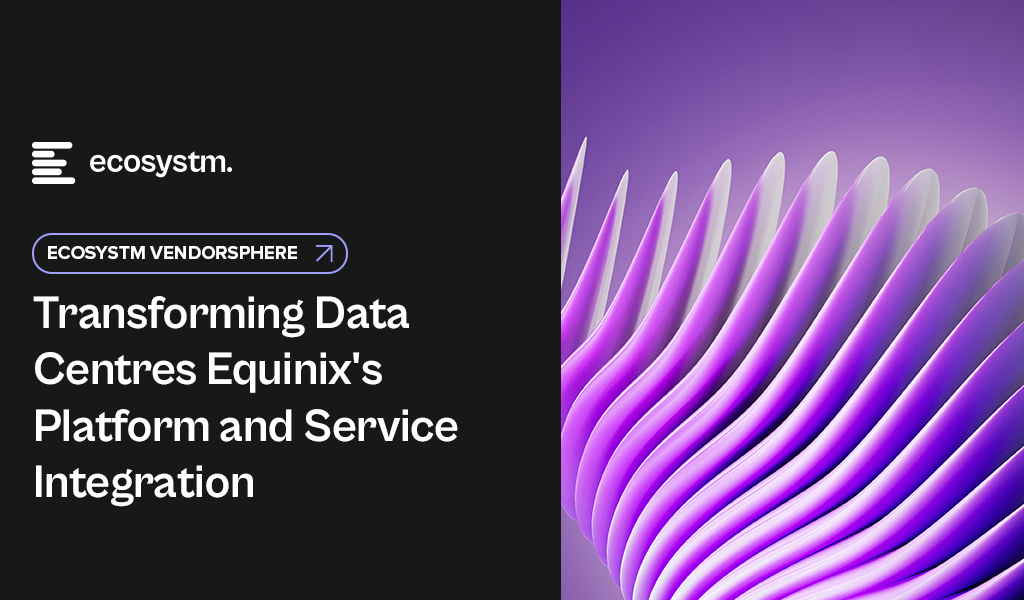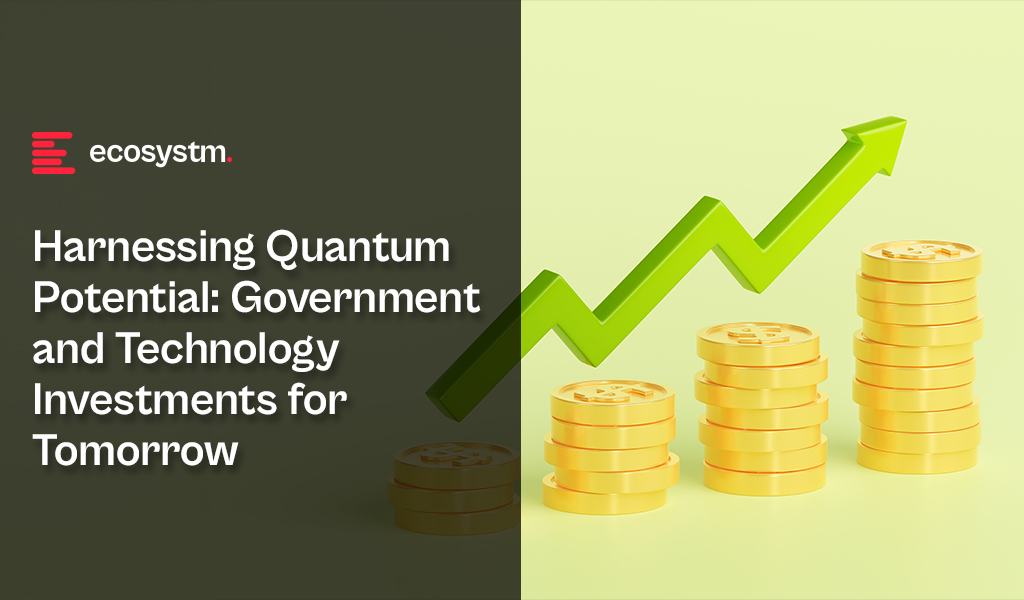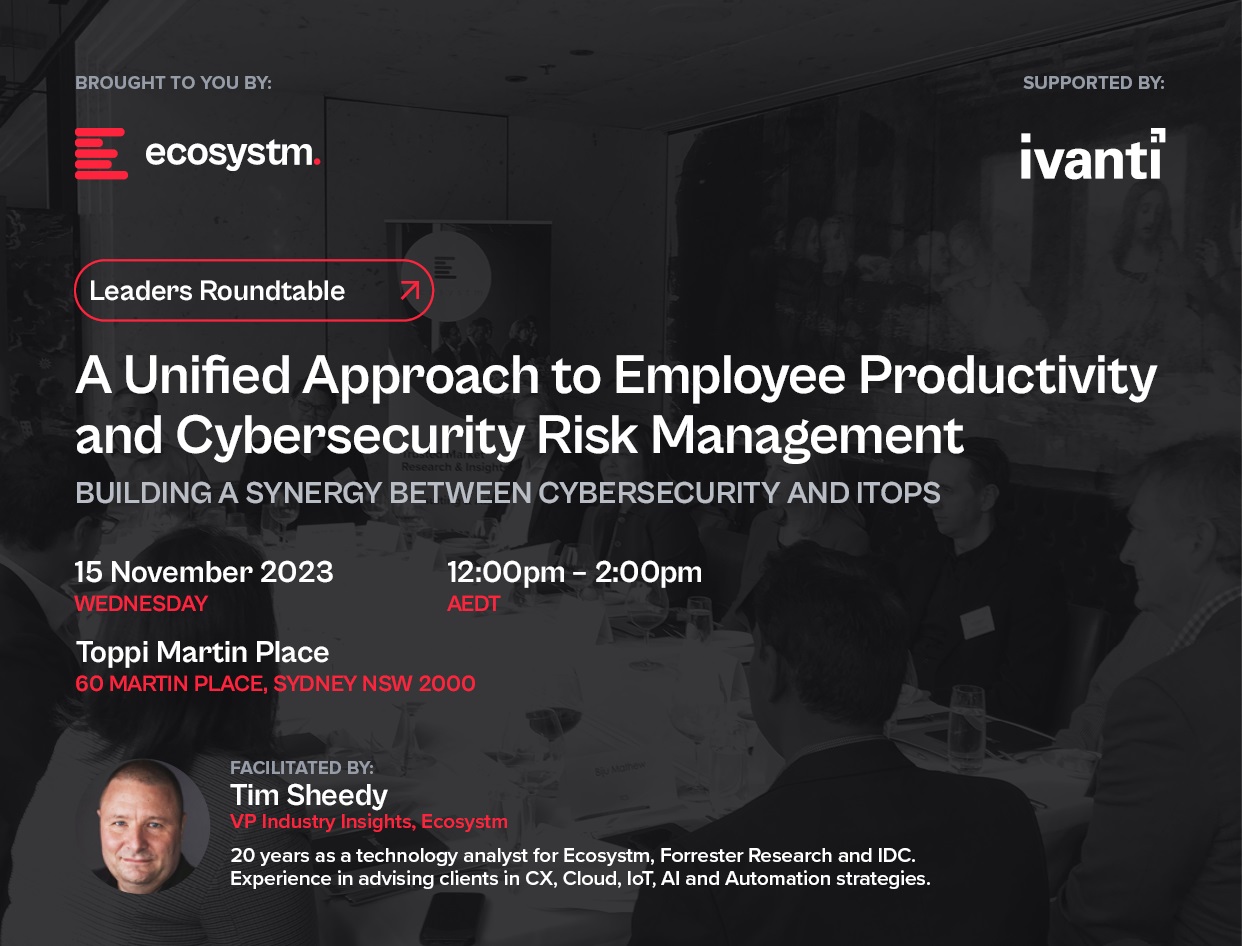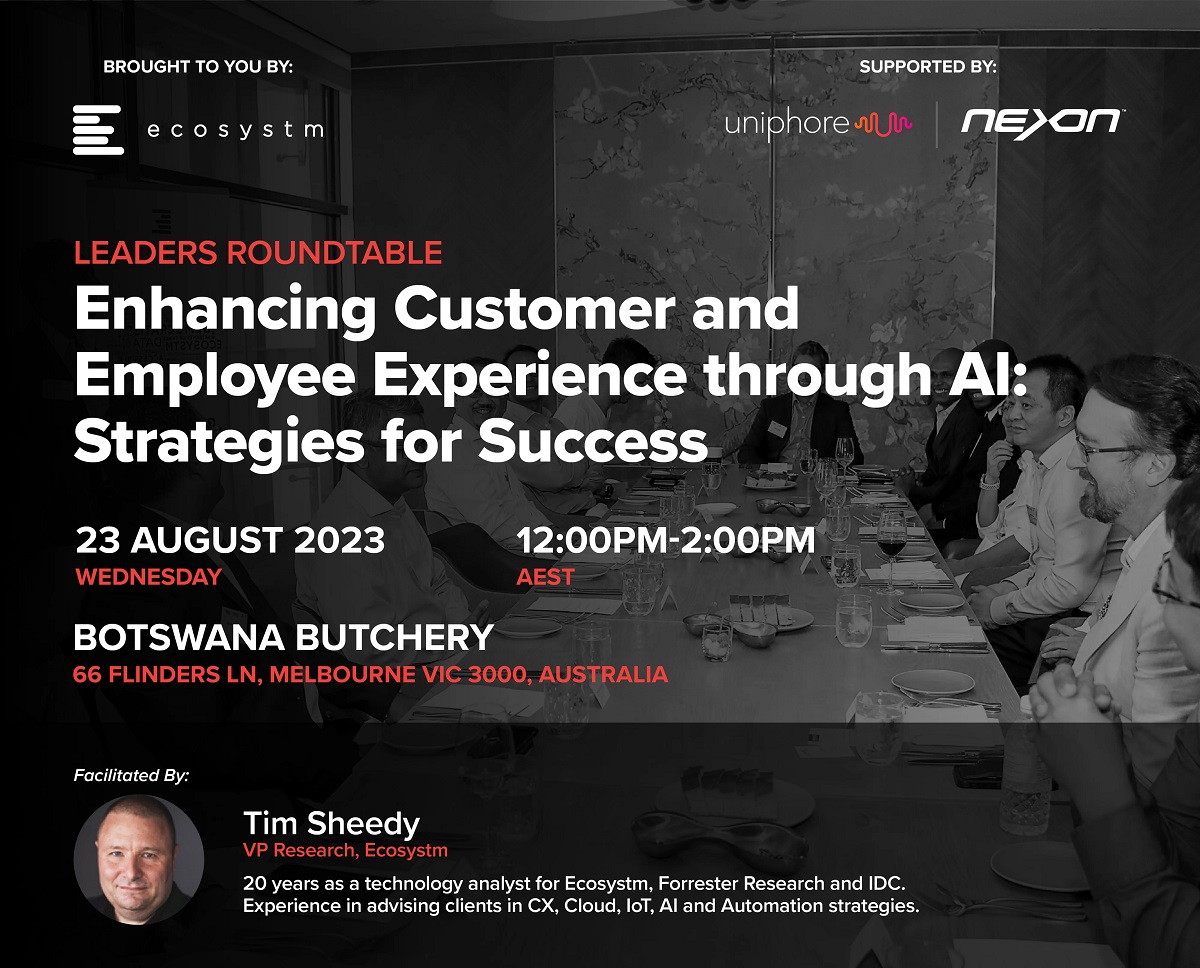Leaders Roundtable: From Boardroom to Endpoint: A Comprehensive Approach to Cybersecurity
We’ve concluded another successful event! Thanks to everyone for their Valuable contributions.
->Click here to explore hightlights and key takeaways from this Roundtable session.
Cyber threats are continuously evolving, with attackers developing increasingly sophisticated methods to exploit vulnerabilities. This makes cybersecurity a never-ending arms race.
Leaders Roundtable: Don’t Gamble Away Your Customer Trust: Reliable GenAI Needs Better Knowledge Management
We’ve concluded another successful event! Thanks to everyone for their Valuable contributions.
->Click here to explore hightlights and key takeaways from this Roundtable session.
GenAI is storming the world, with promises to improve the productivity of your teams and drive better customer experiences.
Leaders Roundtable: From Boardroom to Endpoint: A Comprehensive Approach to Cybersecurity
We’ve concluded another successful event! Thanks to everyone for their Valuable contributions.
->Click here to explore hightlights and key takeaways from this Roundtable session.
As AI evolves, the supporting infrastructure has become a crucial consideration for organisations and technology companies alike. AI demands massive processing power and efficient data handling, making high-performance computing clusters and advanced data management systems essential. Scalability, efficiency, security, and reliability are key to ensuring AI systems handle increasing demands and sensitive data responsibly.
Data centres must evolve to meet the increasing demands of AI and growing data requirements.
Equinix recently hosted technology analysts at their offices and data centre facilities in Singapore and Sydney to showcase how they are evolving to maintain their leadership in the colocation and interconnection space.
Equinix is expanding in Latin America, Africa, the Middle East, and Asia Pacific. In Asia Pacific, they recently opened data centres in Kuala Lumpur and Johor Bahru, with capacity additions in Mumbai, Sydney, Melbourne, Tokyo, and Seoul. Plans for the next 12 months include expanding in existing cities and entering new ones, such as Chennai and Jakarta.
Ecosystm analysts comment on Equinix’s growth potential and opportunities in Asia Pacific.
Small Details, Big Impact
TIM SHEEDY. The tour of the new Equinix data centre in Sydney revealed the complexity of modern facilities. For instance, the liquid cooling system, essential for new Nvidia chipsets, includes backup cold water tanks for redundancy. Every system and process is designed with built-in redundancy.
As power needs grow, so do operational and capital costs. The diesel generators at the data centre, comparable to a small power plant, are supported by multiple fuel suppliers from several regions in Sydney to ensure reliability during disasters.
Security is critical, with some areas surrounded by concrete walls extending from the ceiling to the floor, even restricting access to Equinix staff.
By focusing on these details, Equinix enables customers to quickly set up and manage their environments through a self-service portal, delivering a cloud-like experience for on-premises solutions.
Equinix’s Commitment to the Environment
ACHIM GRANZEN. Compute-intensive AI applications challenge data centres’ “100% green energy” pledges, prompting providers to seek additional green measures. Equinix addresses this through sustainable design and green energy investments, including liquid cooling and improved traditional cooling. In Singapore, one of Equinix’s top 3 hubs, the company partnered with the government and Sembcorp to procure solar power from panels on public buildings. This improves Equinix’s power mix and supports Singapore’s renewable energy sector.
TIM SHEEDY Building and operating data centres sustainably is challenging. While the basics – real estate, cooling, and communications – remain, adding proximity to clients, affordability, and 100% renewable energy complicates matters. In Australia, reliant on a mixed-energy grid, Equinix has secured 151 MW of renewable energy from Victoria’s Golden Plains Wind Farm, aiming for 100% renewable by 2029.
Equinix leads with AIA-rated data centres that operate in warmer conditions, reducing cooling needs and boosting energy efficiency. Focusing on efficient buildings, sustainable water management, and a circular economy, Equinix aims for climate neutrality by 2030, demonstrating strong environmental responsibility.
Equinix’s Private AI Value Proposition
ACHIM GRANZEN. Most AI efforts, especially GenAI, have occurred in the public cloud, but there’s rising demand for Private AI due to concerns about data availability, privacy, governance, cost, and location. Technology providers in a position to offer alternative AI stacks (usually built on top of a GPU-as-a-service model) to the hyperscalers find themselves in high interest. Equinix, in partnership with providers such as Nvidia, offers Private AI solutions on a global turnkey AI infrastructure. These solutions are ideal for industries with large-scale operations and connectivity challenges, such as Manufacturing, or those slow to adopt public cloud.
SASH MUKHERJEE. Equinix’s Private AI value proposition will appeal to many organisations, especially as discussions on AI cost efficiency and ROI evolve. AI unites IT and business teams, and Equinix understands the need for conversations at multiple levels. Infrastructure leaders focus on data strategy capacity planning; CISOs on networking and security; business lines on application performance, and the C-suite on revenue, risk, and cost considerations. Each has a stake in the AI strategy. For success, Equinix must reshape its go-to-market message to be industry-specific (that’s how AI conversations are shaping) and reskill its salesforce for broader conversations beyond infrastructure.
Equinix’s Growth Potential
ACHIM GRANZEN. In Southeast Asia, Malaysia and Indonesia provide growth opportunities for Equinix. Indonesia holds massive potential as a digital-savvy G20 country. In Malaysia, the company’s data centres can play a vital part in the ongoing Mydigital initiative, having a presence in the country before the hyperscalers. Also, the proximity of the Johor Bahru data centre to Singapore opens additional business opportunities.
TIM SHEEDY. Equinix is evolving beyond being just a data centre real estate provider. By developing their own platforms and services, along with partner-provided solutions, they enable customers to optimise application placement, manage smaller points of presence, enhance cloud interconnectivity, move data closer to hyperscalers for backup and performance, and provide multi-cloud networking. Composable services – such as cloud routers, load balancers, internet access, bare metal, virtual machines, and virtual routing and forwarding – allow seamless integration with partner solutions.
Equinix’s focus over the last 12 months on automating and simplifying the data centre management and interconnection services is certainly paying dividends, and revenue is expected to grow above tech market growth rates.
Despite an increase in energy efficiency investment, the construction sector’s energy consumption and CO₂ emissions have rebounded to an all-time high. Buildings currently contribute 39% of global energy-related carbon emissions – 28% from operational needs like heating and cooling, and 11% from construction materials.
In the next three decades, with the global population expected to reach 9.7 billion, the construction industry will face the pressure to meet growing infrastructure and housing demands while adapting to stricter environmental regulations.
The urgency of climate action demands that governments mandate low-carbon practices in urban development.
Increase Use of Low-Carbon Materials
Traditional building materials like concrete, steel, and brick are strong and durable but environmentally costly. This high embodied carbon footprint is prompting a shift towards low-carbon alternatives. Indonesia is using ‘green cement’ – made using environmentally friendly materials – in the development of its new futuristic capital Nusantara. This has led to an estimated reduction in carbon emissions of up to 38% per tonne of cement so far.
Nordic countries are setting ambitious targets for low-carbon materials. Starting in 2025, Finland will require life cycle assessments and material declarations in construction to reduce emissions, detailing building components and material origins. Denmark is also prioritising low-carbon materials through energy-efficient designs, sustainable materials, and stringent building codes.
Mandate Whole-Life Carbon Emission Assessments
Whole Life-Cycle Carbon (WLC) emissions encompass all the carbon a building generates throughout its lifespan, from material extraction to demolition and disposal. Assessing WLC gives a comprehensive understanding of a building’s total environmental impact.
The London Plan is a roadmap for future development and achieving the goal of a zero-carbon city. The plan includes provisions for WLC analysis, specific energy hierarchies, and strategies to reduce London’s carbon footprint.
With a bold vision of a fully circular city by 2050, the Amsterdam Circular Strategy 2020-2025 lays out a comprehensive roadmap to achieve this goal. Key elements include mapping material flows to reduce reliance on virgin resources and mandating WLC assessments.
Enforce Clean Construction Standards
From green building codes to tax incentives, governments around the world are implementing innovative strategies to encourage sustainable building practices.
The Philippines’ National Building Code requires green building standards and energy efficiency measures for new buildings.
Seattle offers expedited permits for projects meeting embodied carbon standards, speeding up eco-friendly construction, and reinforcing the city’s environmental goals.
New Jersey offers businesses a tax credit of up to 5% for using low-carbon concrete and an additional 3% for concrete made with carbon capture technology.
Promote Large-Scale Adaptive Reuse
Large-scale adaptive reuse includes reducing carbon emissions by making existing buildings and infrastructure a larger part of the climate solution.
London’s Battersea Power Station restored its iconic chimneys and Art Deco façade, transforming it into a vibrant hub with residential, commercial, and leisure spaces.
The High Line in New York has been transformed into a public park with innovative landscaping, smart irrigation, and interactive art installations, enhancing visitor experience and sustainability.
Singapore using adaptive reuse to rejuvenate urban and industrial spaces sustainably. The Jurong Town Corporation is repurposing a terrace factory for sustainable redevelopment and preserving industrial heritage. In Queenstown, historical buildings in Tanglin Halt are being reused to maintain historical significance and add senior-friendly amenities.
Establish Circular Economy
As cities worldwide start exploring ways to go circular, some are already looking into different ways to leverage innovative practices to implement circular initiatives.
Toronto is embedding circular criteria into procurement by requiring circular economy profiles, vendor action plans, and encouraging circular design for parklets. The city also recommends actions for transitioning to a circular economy and is developing e-learning on circular procurement for staff.
Japan uses Building Information Modeling to optimise resource consumption and reduce waste during construction, with a focus on using recycled materials to promote sustainability in building projects.
Adopt Electric Vehicles
The share of EVs increased from 4% in 2020 to 18% in 2023 and is expected to grow in 2024. This trend reflects a global shift toward cleaner transportation, driven by technological advancements and rising environmental awareness.
The Delhi EV Policy aims to expand charging infrastructure and incentives, targeting 18,000 charging points by 2024, with 25% EV registrations and one charging outlet per 15 EVs citywide.
Singapore is adopting EVs to reduce land transport emissions as part of its net-zero goal, aiming to cut emissions by 1.5 to 2 million tonnes. The EV Roadmap targets cost parity with internal combustion engine (ICE) vehicles and 60,000 charging points by 2030.
Australia has set new rules to limit vehicle pollution, encouraging car makers to sell more electric vehicles and reduce transportation pollution.
Promote Circular Economy Marketplaces
Circular marketplaces play an important role in the new economy, changing the way we use, manufacture, and purpose materials and products.
The UK’s Material Reuse Portal aggregates surplus construction materials post-deconstruction, offering guidance and connections to service providers. It integrates with various data sources, can be customised for different locations, and provides free access to sustainable materials. Future plans include expanding marketplace partnerships to enhance material reuse.
Build Reuse is a US-based online marketplace specialising in salvaged and surplus building materials. It connects buyers and sellers for reclaimed items like wood, bricks, fixtures, and architectural elements, promoting resource efficiency and reducing construction waste.
Quantum computing is emerging as a groundbreaking force with the potential to reshape industries and enhance national security with unparalleled speed and precision. Governments and technology providers worldwide are heavily investing in this transformative technology, which promises significant advancements in areas such as cryptography, drug development, AI, and finance. Countries like Australia, Singapore, Taiwan, Qatar, and the UK are investing heavily in quantum research, backed by tech giants like Nvidia, IBM, and Google.
Ecosystm research finds that nearly 30% of enterprises are expecting to use quantum computing in the next 5 years.
Beyond Bits: Exploring the Potential of Quantum Computers
We need quantum computers because they have the potential to solve certain problems that are impossible (or impractical) for classical computers. Last year, Google led a study revealing that its quantum processor can complete a task in 6.18 seconds that would take a traditional supercomputer 47 years.
Here are a few reasons why quantum computing is exciting:
Unleashing the power of qubits. While classical computers use bits that can be either 0 or 1, quantum computers use qubits, which can exist in both states simultaneously (a state called superposition). This allows them to explore multiple possibilities simultaneously, making them significantly faster for specific tasks.
Tackling complex problems. Problems like simulating molecules or breaking complex encryption codes involve massive calculations. Quantum computers, with their unique properties, can manage these complexities more efficiently.
Revolutionising specific fields. Quantum computing has the potential to transform areas such as materials science, drug discovery, AI, and financial modelling. By simulating complex systems and processes, they could lead to breakthroughs in various sectors.
Quantum computers will not replace traditional computers entirely, but rather function as powerful tools for specific tasks beyond the reach of classical machines. Let’s look at cybersecurity as an example.
Twenty years ago, hacking was a basic task. Imagine a time before social media, when a simple computer and basic technical know-how were enough to breach a network. The stakes were low, the landscape uncomplicated. But technology, like threats, has evolved. Today’s hackers use sophisticated techniques, employing strategies like “harvest now, decrypt later” – stealing data today to decrypt later using more powerful machines. This is where quantum computing enters the scene, posing a significant threat to current encryption methods. In response, tech giants like Google, Apple, and Zoom are implementing quantum-resistant encryption into their software, safeguarding user data from potential future decryption attempts. Governments and telecommunication providers worldwide are boosting quantum encryption to tackle the potential security crisis.
The thrill of quantum computing lies in its infancy. Unforeseen applications, beyond our current imagination, could be unlocked as the technology matures.
Current Quantum Projects Focused on Security
First Scalable Network Secures Maritime Trade. The Netherlands is improving the resiliency of transport infrastructure in their own major international maritime hub, using quantum. The Port of Rotterdam Authority joined a collection of quantum technology firms to create a comprehensive cybersecurity ecosystem – the first of its kind globally. The port uses quantum technology to safeguard sensitive information, improving safety for the seagoing vessels carrying 470 million tonnes of cargo annually.
UK Integrates Quantum Navigation for Secure Air Travel. The UK is improving its digital transport infrastructure by integrating the first ever un-jammable aviation navigation system, powered by quantum software. This initiative was prompted by an incident where a government plane carrying the UK defence secretary had its GPS signal jammed close to Russian territory. This technology ensures safe and reliable navigation for aircraft, particularly in hostile environments. The UK government is investing USD 56 million into their quantum sector, aiming to become a quantum-enabled economy by 2033.
Governments Putting Faith in Quantum
Taiwan’s First Domestic 5-Qubit Computer. Taiwan is aiming to be a leader in quantum computing by building its first domestic machine by 2027. This initiative is part of a larger USD 259 million, five-year plan for quantum technology, and has a multi-pronged approach including building the actual quantum computer hardware; developing solutions to secure data in a world with quantum computers (quantum cryptography); creating a strong supply chain for quantum computing components within Taiwan; and collaborating with international partners to develop testing platforms and expertise.
Singapore Explores Real-World Applications. The Singaporean government has pledged USD 518 million to their National Quantum Strategy (NQS). This investment will provide the necessary resources to explore real-time applications of quantum technology in healthcare and technology. Simultaneously, they launched the National Quantum Processor Initiative (NQPI) to develop quantum sensors that will aid in research. Singapore aims to lead the world in quantum tech for investment portfolios, cryptography, and drug discovery.
Australia Aiming for World’s First Utility-Scale Machine. Backed by a USD 620 million investment from the Australian and Queensland governments, PsiQuantum aims to build a fault-tolerant computer that can solve previously challenging problems in fields like renewable energy, healthcare, and transportation. PsiQuantum’s innovative “fusion-based architecture” tackles scaling challenges by using millions of light-based qubits, paving the way for a new era of computational power and potentially sparking the next industrial revolution. This project positions Australia as a global leader in harnessing the immense potential of quantum computing.
Tech Companies Making the Quantum Leap
IBM Enhances Quantum Performance. IBM’s latest quantum computing platform, Qiskit 1.0, has worked on features that enhance performance, stability, and reliability. The updated open-source SDK aims to facilitate accessible quantum programming and accelerate processing times. Qiskit 1.0 uses optimised circuits to create and manage the interplay between classical and quantum computing. IBM is even collaborating with Japan’s AIST to develop a 10,000-qubit quantum computer by 2029, which is 75 times more powerful than current systems.
Microsoft and Quantinuum Achieve Reliable Logical Qubits. This significant milestone is said to mark a new era of dependable quantum technology, dramatically reducing errors and enhancing the precision of quantum computations. They have demonstrated an 800x improvement in error rates, paving the way for hybrid supercomputing systems that combine AI, high-performance computing (HPCs), and quantum capabilities to tackle scientific problems, with new capabilities becoming available to Azure Quantum Elements customers in the coming months.
Quantum Cloud Services for Enterprise. Major tech players QMware, Nvidia, and Oracle are teaming up to create hybrid quantum computing service for businesses. Combining classical and quantum computing, the project aims to crunch complex problems in AI, machine learning, and optimisation – all in the cloud.
Building Towards a Quantum Future
In the short term, using HPCs with quantum algorithms can already provide noticeable speed improvements over traditional methods. Hybrid approaches, where HPCs and quantum computers work together, could lead to significant gains in speed and efficiency, potentially ranging from 10x to 100x improvement.
Three strategies: quantum-inspired, hybrid, and full-scale quantum computing each offer distinct advantages.
While quantum-inspired computing leverages quantum algorithms to run on classical systems, hybrid computing combines classical and quantum processors, optimising the strengths of both to take complex problems more efficiently. Intuitively, full-scale quantum computing represents the ultimate goal, where large, fault-tolerant quantum computers solve problems beyond the reach of current classical systems.
Looking further ahead, the development of large-scale quantum computers could revolutionise industries by solving problems far beyond the reach of classical computers, with potential speedups of 500x to 1000x.
As quantum technology progresses, different industries and applications will benefit from tailored approaches that best suit their unique needs.



